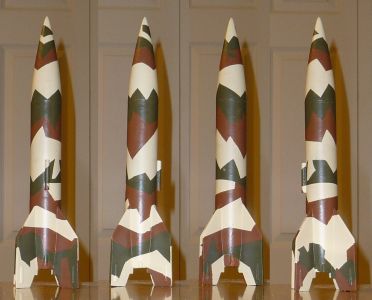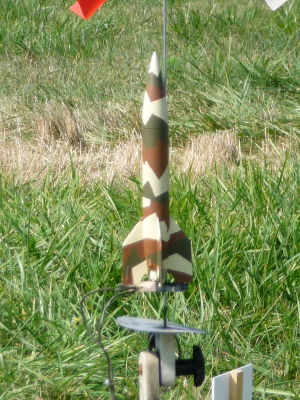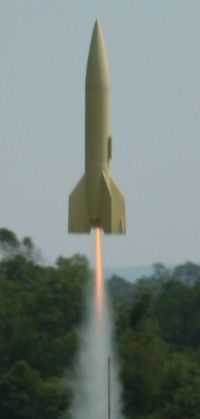| Construction Rating: | starstarstarstarstar_border |
| Flight Rating: | starstarstarstarstar |
| Overall Rating: | starstarstarstarstar_border |
| Diameter: | 1.33 inches |
| Length: | 11.25 inches |
| Manufacturer: | Semroc  |
| Skill Level: | 2 |
| Style: | Scale |

Brief:
The V2 xKit is a reproduction of Estes K-22, which was originally released in 1965. Like the original, it flies on 18mm motors and features balsa nose and tail cones. The xKits don't come with instructions but, since they are classics, copies of the original instructions are available on-line. This was my favorite rocket as a kid, and I couldn't resist grabbing one.
Construction:
The parts list:
- BNC-55F balsa nose cone
- BTC-55Z balsa tail cone
- BT-55 body tube
- BT-20 motor tube
- Launch lugs (3)
- Engine block
- Washer weight
- Large screw eye
- Rubber shock cord
- Gauze for cord attachment
- Plastic parachute with separate shroud lines and tape disks.
- Laser cut balsa fins and servo pods
- Dummy casing
- Pattern sheet

The parts provided are true to the original kit. The main difference is the fins are laser cut with both scale and semi-scale versions. The surface of the cones is nice and the tube has almost no spirals. The only negative is the hole in the tail cone is not perfectly centered. This won't hurt and probably is true to the original. However, after seeing Semroc's other products, I was surprised.
Despite the fact that the xKits are recommended for expert modelers, I could have built the kit without any. Well, except for positioning the balsa servo pods and cutting the extra launch lugs into the scale turbine exhaust and pull-out plug details. If you build an xKit, be sure to read the online instructions and the sheet provided with the kit. The provided information includes interesting but unnecessary factoids about Estes and the real V2 as well as a few key bits of data. The instructions identify the CP for both the provided scale and semi-scale fin sets. Also, it's noted that the supplied washer and screw eye are sufficient for the larger semi-scale fins, but ~½oz of additional weight is required for the scale set (not supplied)!
The pattern sheet includes fin patterns and fin alignment guides. The latter have been improved from the originals, which required that the upper and lower guides be aligned by eyeball. Semroc's have a flat face which allows them to be aligned on any flat surface. Simple but a good improvement. I opted for the larger semi-scale fins as I'm not a stickler and these should make sure the rocket is stable in varied launch conditions. The only reason you'll need the fin patterns is for the placement of the balsa servo pods. I merely eyeballed them.
I added a Kevlar leader and ditched the gauze reinforcement. I wound it around the motor tube, tacked it place with CA and then attached the motor mount with 5-minute epoxy. The original kit said to install the motor mount so the engine was flush with the bottom of the mount. I opted for some overhang to help with friction fitting. I checked stability prior to permanently attaching the nose weight just in case some more was needed. Once verified, I removed the screw eye, filled the hole and nose cone surface with white glue, and reattached the weight. I considered adding a motor hook but decided to keep it like the original.

Finishing:
I used Elmer's Fill 'n' Finish to fill the balsa parts and then shot several coats of primer. I laid down a base coat of Model Masters 'modern' desert tan and added brown and olive drab camo patterns. It looks good from 10 feet...
Construction Rating: 4 out of 5
Flight and Recovery:
I've flown it twice. I friction fit the B6-4 motors and added an ample amount of dog barf wrapped in a section of Estes wadding. I used the stock chute, which is typical plastic with twine and tape discs.
The boost was nice and fast. I couldn't see for sure, but it looked like ejection was early. It recovered fine and the combo of Kevlar and the stock rubber band was sufficient to keep the cone from whacking the body. There wasn't a smile to be seen (except on my face).

Flight Rating: 5 out of 5
Summary:
This is an easy to build yet detailed little kit and it flies great!
Overall Rating: 4 out of 5
Lift-Off Picture from NARAM Live! by Chris Taylor
Other Reviews
- Semroc V2 (xKit) By Dick Stafford (October 12, 2008)
This is the second Semroc V2 that I’ve built. You can see my earlier review elsewhere on this site along with (at least) one other opinion of this kit. I won’t repeat a bunch of background in this review and instead will focus on what I found and did differently. Most obviously, this build utilized scale fins whereas my previous V2 has the larger semi-scale fins (laser-cut ...
- Semroc V2 (xKit) By Chan Stevens (September 6, 2008)
A "bag of parts" clone kit, in this case a reproduction of the K-22 V-2. For many modelers, this was their first introduction to scale model rocketry. The V-2 was a German developed missile, and as WWII drew to a conclusion, it was the most capable rocket in the world. When America brought Werner von Braun and his crew over from Germany, the V-2 knowledge gave us the much needed jump start to ...
 |
 |
Flights
 |
 |
 |
 |
D.S. (September 17, 2008)